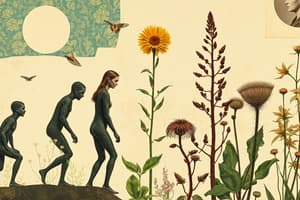Podcast
Questions and Answers
What characteristics distinguish plants from their algal ancestors?
What characteristics distinguish plants from their algal ancestors?
Plants are multicellular, have plastids, and primarily live on land, whereas algae are mostly aquatic.
What key adaptations allowed plants to survive on land?
What key adaptations allowed plants to survive on land?
Development of a cuticle to prevent water loss, stomata for gas exchange, and structures like vascular tissue for support and transport.
What is the significance of plastids in plant cells?
What is the significance of plastids in plant cells?
Plastids, including chloroplasts, are responsible for photosynthesis and other biosynthetic processes.
How do land plants differ from their closest green algal relatives?
How do land plants differ from their closest green algal relatives?
From which group of algae did land plants evolve?
From which group of algae did land plants evolve?
What is the haploid-dominant (zygotic) life cycle, and in which organisms is it found?
What is the haploid-dominant (zygotic) life cycle, and in which organisms is it found?
What is alternation of generations, and how does it differ from the zygotic life cycle?
What is alternation of generations, and how does it differ from the zygotic life cycle?
How do gametophytes function in plant reproduction?
How do gametophytes function in plant reproduction?
What structures protect plant gametes from desiccation?
What structures protect plant gametes from desiccation?
What are the main differences between gametophytes and sporophytes?
What are the main differences between gametophytes and sporophytes?
What are the nine major phyla of plants?
What are the nine major phyla of plants?
What traits distinguish bryophytes from other plant groups?
What traits distinguish bryophytes from other plant groups?
Why are bryophytes typically found in moist environments?
Why are bryophytes typically found in moist environments?
What adaptations do bryophytes have for reproduction?
What adaptations do bryophytes have for reproduction?
How do liverworts differ from mosses and hornworts?
How do liverworts differ from mosses and hornworts?
What is the role of rhizoids in bryophytes?
What is the role of rhizoids in bryophytes?
What is the significance of vascular tissue in plants?
What is the significance of vascular tissue in plants?
How do lycophytes differ from pteridophytes?
How do lycophytes differ from pteridophytes?
What features define seedless vascular plants?
What features define seedless vascular plants?
How do lycophytes transport water and nutrients?
How do lycophytes transport water and nutrients?
What are tracheophytes, and what adaptations do they have for land?
What are tracheophytes, and what adaptations do they have for land?
Why were lycophytes and pteridophytes more abundant in the past?
Why were lycophytes and pteridophytes more abundant in the past?
What structures in ferns house spores?
What structures in ferns house spores?
How do the sporophyte and gametophyte stages differ in ferns?
How do the sporophyte and gametophyte stages differ in ferns?
What role do sori play in fern reproduction?
What role do sori play in fern reproduction?
What climate changes during the Carboniferous period led to the dominance of gymnosperms?
What climate changes during the Carboniferous period led to the dominance of gymnosperms?
What are the four major groups of gymnosperms?
What are the four major groups of gymnosperms?
Why are gymnosperm seeds called "naked seeds"?
Why are gymnosperm seeds called "naked seeds"?
What reproductive adaptations do gymnosperms have?
What reproductive adaptations do gymnosperms have?
What are some common characteristics of conifers?
What are some common characteristics of conifers?
What is the main advantage of seeds over spores?
What is the main advantage of seeds over spores?
How do ovules develop into seeds?
How do ovules develop into seeds?
What is heterospory, and how is it beneficial?
What is heterospory, and how is it beneficial?
What is the function of a pollen tube?
What is the function of a pollen tube?
How do gymnosperms disperse their seeds?
How do gymnosperms disperse their seeds?
What distinguishes angiosperms from gymnosperms?
What distinguishes angiosperms from gymnosperms?
What are the two major groups of angiosperms?
What are the two major groups of angiosperms?
How do flowers contribute to angiosperm success?
How do flowers contribute to angiosperm success?
What role does endosperm play in angiosperm seeds?
What role does endosperm play in angiosperm seeds?
What is double fertilization in angiosperms?
What is double fertilization in angiosperms?
How do fruits aid in seed dispersal?
How do fruits aid in seed dispersal?
What are some key differences between monocots and eudicots?
What are some key differences between monocots and eudicots?
What adaptations allow angiosperms to transport water efficiently?
What adaptations allow angiosperms to transport water efficiently?
How have angiosperms co-evolved with pollinators?
How have angiosperms co-evolved with pollinators?
Why is seed dormancy an important adaptation?
Why is seed dormancy an important adaptation?
How did early land plants contribute to atmospheric changes?
How did early land plants contribute to atmospheric changes?
What is placental transfer tissue, and why is it significant?
What is placental transfer tissue, and why is it significant?
Why was the origin of land plants crucial for animal colonization?
Why was the origin of land plants crucial for animal colonization?
How did gymnosperms and angiosperms shape modern ecosystems?
How did gymnosperms and angiosperms shape modern ecosystems?
What major advantage do angiosperms have over gymnosperms?
What major advantage do angiosperms have over gymnosperms?
Flashcards
Distinguishing characteristics of plants
Distinguishing characteristics of plants
Plants are multicellular, have plastids, and primarily live on land, while algae are mostly aquatic.
Plant adaptations for land survival
Plant adaptations for land survival
Cuticle (prevent water loss), stomata (gas exchange), and vascular tissue (support and transport).
Significance of plastids in plants
Significance of plastids in plants
Plastids, including chloroplasts, perform photosynthesis and other biosynthetic processes.
Land plants vs. green algae
Land plants vs. green algae
Signup and view all the flashcards
Origin of land plants
Origin of land plants
Signup and view all the flashcards
Haploid-dominant lifecycle
Haploid-dominant lifecycle
Signup and view all the flashcards
Alternation of generations
Alternation of generations
Signup and view all the flashcards
Function of gametophytes
Function of gametophytes
Signup and view all the flashcards
Protecting plant gametes
Protecting plant gametes
Signup and view all the flashcards
Gametophytes vs. Sporophytes
Gametophytes vs. Sporophytes
Signup and view all the flashcards
Traits of Bryophytes
Traits of Bryophytes
Signup and view all the flashcards
Bryophytes in moist environments
Bryophytes in moist environments
Signup and view all the flashcards
Bryophyte adaptations for reproduction
Bryophyte adaptations for reproduction
Signup and view all the flashcards
Significance of vascular tissue
Significance of vascular tissue
Signup and view all the flashcards
Seedless Vascular Plants
Seedless Vascular Plants
Signup and view all the flashcards
Angiosperms vs gymnosperms
Angiosperms vs gymnosperms
Signup and view all the flashcards
Monocots vs. Eudicots
Monocots vs. Eudicots
Signup and view all the flashcards
Advantages of seeds over spores
Advantages of seeds over spores
Signup and view all the flashcards
Angiosperms transporting water
Angiosperms transporting water
Signup and view all the flashcards
Function of pollen tube
Function of pollen tube
Signup and view all the flashcards
Study Notes
- Plants are primarily multicellular, have plastids, and live on land, while algae are mostly aquatic
Plant Adaptations for Land Survival
- Development of a cuticle to prevent water loss
- Stomata for gas exchange
- Vascular tissue for support and transport
Significance of Plastids
- Plastids, including chloroplasts, enable photosynthesis and other biosynthetic processes in plant cells
Land Plant Distinctions
- Land plants possess multicellular tissues
- Exhibit alternation of generations
- Have specialized reproductive structures like gametangia
Evolution from Algae
- Land plants evolved from streptophyte algae, similar to Charophycean algae
Haploid-Dominant Life Cycle
- Involves a reproductive cycle where the haploid stage dominates
- Found in some algae
Alternation of Generations
- Includes both multicellular haploid (gametophyte) and diploid (sporophyte) stages
- Differs from the zygotic cycle, where the diploid phase is brief
Gametophyte Function
- Gametophytes produce haploid gametes through mitosis that fuse to form a diploid zygote
Gamete Protection
- Gametangia (antheridia for sperm and archegonia for eggs) protect gametes from desiccation
Gametophytes vs. Sporophytes
- Gametophytes are haploid and produce gametes
- Sporophytes are diploid and produce spores
Nine Major Phyla of Plants
- Hepatophyta (liverworts)
- Bryophyta (mosses)
- Anthocerophyta (hornworts)
- Lycophyta (lycophytes)
- Pteridophyta (ferns)
- Cycadophyta (cycads)
- Ginkgophyta (ginkgos)
- Coniferophyta (conifers)
- Anthophyta (angiosperms)
Bryophyte Traits
- Bryophytes lack vascular tissue
- Have dominant gametophytes
- Require water for sperm movement
Bryophyte Moist Environments
- Bryophytes need water for reproduction
- Sperm are flagellated and require water to swim to the egg
Bryophyte Adaptations for Reproduction
- Bryophytes produce spores with tough walls
- Rely on water for fertilization
- Have protective gametangia
Liverwort Distinctions
- Liverworts lack true stomata
- Mosses and hornworts possess stomata
Rhizoid Role
- Rhizoids anchor the plant and aid in water absorption
- Rhizoids do not function like true roots
Vascular Tissue Significance
- Vascular tissue (xylem and phloem) transports water, nutrients, and food
- Allows plants to grow larger
Lycophyte Distinctions
- Lycophytes have microphylls (small leaves with a single vein)
- Pteridophytes have megaphylls (larger leaves with multiple veins)
Seedless Vascular Plant Features
- Seedless vascular plants possess vascular tissue
- Reproduce via spores instead of seeds
Lycophyte Transport
- Lycophytes use xylem for water transport
- Lycophytes use phloem for nutrient distribution
Tracheophytes
- Tracheophytes are plants with vascular tissue
- Enables efficient water transport and structural support
Lycophyte and Pteridophyte Abundance
- Lycophytes and pteridophytes dominated Carboniferous forests
- Made vast swampy ecosystems, but declined as climate changed
Fern Spore Housing
- Spores are housed in sporangia
- Often grouped into clusters called sori
Fern Stage Differences
- The sporophyte is the dominant stage
- The gametophyte is small and free-living
Sori in Fern Reproduction
- Sori contain sporangia that produce spores for reproduction
Gymnosperm Dominance
- Cooler and drier conditions caused the decline of lycophytes and pteridophytes
- Enabled gymnosperms to diversify
Four Major Gymnosperm Goups
- Cycadophyta (cycads)
- Ginkgophyta (ginkgos)
- Coniferophyta (conifers)
- Gnetophyta (gnetophytes)
Gymnosperm Seeds
- Gymnosperm seeds are termed "naked seeds"
- Gymnosperm seeds are not enclosed by fruit, unlike angiosperm seeds
Gymnosperm Reproductive Adaptations
- Gymnosperms produce seeds and pollen
- Gymnosperms allow fertilization without water
Conifer Characteristics
- Conifers have needle-like leaves
- Most conifers produce cones
- Many conifers are evergreen
Seed Advantages
- Seeds provide protection and nourishment
- Seeds can remain dormant until favorable conditions
Ovule Development
- After fertilization, the ovule matures into a seed containing an embryo, nutritive tissue, and a protective seed coat
Heterospory
- Heterospory increases cross-fertilization and genetic diversity, by producing two types of spores (microspores and megaspores)
Pollen Tube Function
- A pollen tube delivers sperm directly to the egg
- Eliminates the need for water in fertilization
Gymnosperm Seed Dispersal
- Seeds are dispersed by wind, animals, or other environmental factors
Angiosperm Distinctions
- Angiosperms have flowers and fruits
- Flowers and fruits protect and aid in seed dispersal
Two Major Angiosperm Groups
- Monocots (one cotyledon)
- Eudicots (two cotyledons)
Flower Contribution
- Flowers attract pollinators
- Increases reproductive efficiency and genetic variation
Endosperm Role
- Endosperm provides nutrients for the developing embryo
Double Fertilization
- One sperm fertilizes the egg (forming an embryo)
- The other sperm forms the triploid endosperm
Fruits and Seed Dispersal
- Fruits attract animals that eat and spread them
- Fruits use wind/water for dispersal
Monocot vs. Eudicot
- Monocots have parallel-veined leaves
- Eudicots have net-veined leaves
Efficient Water Transport
- Angiosperms have vessel elements in their xylem
- They are more efficient than tracheids
Pollinator Co-evolution
- Specific flower traits attract certain pollinators
- Increases fertilization success
Seed Dormancy
- Seed dormancy allows seeds to survive unfavorable conditions
- Seeds germinate at the right time
Early Plant Atmospheric Impact
- Early land plants increased oxygen levels
- Early land plants helped develop soil
Placental Transfer Tissue
- Placental transfer tissue allows maternal tissues to nourish developing embryos
- It represents an important evolutionary step
Land Plant Origin Crucial
- Land plants provided oxygen and food
- Land plants made land habitable for animals
Gymnosperm/Angiosperm Ecosystem
- Gymnosperms and angiosperms dominate forests
- They influence climate and support diverse life forms
Angiosperm Advantages
- Angiosperms have more efficient reproduction via flowers, fruits, and diverse pollination strategies
Studying That Suits You
Use AI to generate personalized quizzes and flashcards to suit your learning preferences.




